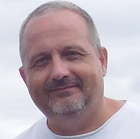
Education:
MSc. solid-state physics; Dept. of Experimental physics, Faculty of Science, UPJŠ, Košice, Slovakia
PhD. solid-state physics; Dept. of Magnetism, Institute of Experimental Physics, Slovak Academy of Sciences, Košice, Slovakia
Research interests:
He is an experienced researcher working in the interdisciplinary teams almost 25 years. His present mission is to develop and implement the theoretical models of the cancer progression with the focus on the concepts of phenotypic plasticity and intratumoral heterogeneity and multi-agent therapies. Before joining CIB group Dr. Horvath worked as junior scientist at the department of theoretical physics of Slovak Academy of Sciences and later in the Department of Theoretical Physics and Astrophysics of the P.J. Šafárik University. The contributions from this periods cover the theory of turbulence and the theory of Ising spin systems. Also worthy of note is his experience with data analysis and numerical modeling, theory and simulation of the complex and biological systems combined with the solving of the optimization problems. Dr. Horvath is entering into development of various interdisciplinary cooperations for many years. Systematic joint research conducted with economic and telecommunication informatics groups at the Technical University of Košice has become an integral part of his research activities.
Education:
MSc. solid-state physics; Dept. of Experimental physics, Faculty of Science, UPJŠ, Košice, Slovakia
PhD. solid-state physics; Dept. of Magnetism, Institute of Experimental Physics, Slovak Academy of Sciences, Košice, Slovakia
Languages:
English, Russian
Positions:
scientific fellow, senior scientist; Institute of Experimental Physics, Košice, Slovak Academy of Sciences (1989-1997)
associate professor, lecturer; Faculty of Natural Science, Šafárik University, Košice, Slovakia, (1997-2002)
data scientist – analyst; SORS research joint stock company, Košice, Slovakia, data scientist and analyst (2009-2011)
scientist, associate prof., lecturer; Technical University of Košice, Faculty of Economics, Dept. of Finance (2011-2012)
Research training:
Bogoliubov Laboratory of Theoretical Physics, Joint Institute for Nuclear Research, Dubna, Russian Federation
Dept. Physics, Helsinki University, Finland
Dept. of Solid State Physics, University of Lodz, Poland
International Centre for Theoretical Physics, Trieste, Italy
Project “le STUDIUM” institute for advanced studies (International research center and hosting foreign associate researchers, organized into a network of European laboratories, based on the Région Centre), CBM (Center de Biophysique Moleculaire Orleans France) CNRS (Centre National de la Recherche Scientifique), group of Theoretical Biophysics, Molecular Simulation, and Scientific Computing
Citations 564, H-index = 12
Buša J., Hnatich M., Honkonen J., Horváth D.: “Stability of Kolmogorov scaling in anisotropically forced turbulence”, Phys. Rev. E, 55 (1997) 381–394.
Kašpárková M., Horváth D., “On positional ordering in a 2-dimensional system of parallel dipoles”, J. Phys.D: Appl.Phys. 25 (1992) 1522–1527.
Horváth D., Orendáčová A., Orendáč M., Jaščur M., Brutovský B., Feher A.: “Ker(MoO4)_2: A quasi one-dimensional S=3/2 Blume-Capel system”, Phys. Rev. B 60 (1999) 1167–1174.
Horváth D., Gmitra M., Vávra I.: “Neural network approach to magnetic dot arrays”, J. Magn. Magn. Mater. 231 (2001) 273–286.
Horváth D., Gmitra M.:“The neural network two-scale model of the magnetic dot array”, J. Magn.Magn.Mater. 263 (2003) 195–213.
Horváth D., Gmitra M., Kuscsik Z.: “The self-organized Monte Carlo localization of the critical point via linear filtering”, Czech. J Phys 54 (2004) 921– 926.
Horváth D., Gmitra M.: “The self-organized multi-lattice Monte Carlo simulation”, Int. J. Mod. Phys. C 15 (2004) 1249–1268.
Reitzner D., Horváth D.: “Multicanonical sampling of vortex states in magnetic nanoelements”,
Physica A 379 (2007) 587–594.
Horváth D., Kneller G.R.: “A least-constraint principle for population dynamics and reaction kinetics,
Modeling entropy-controlled chemical hypercycles”, J. Chem. Phys., 131:171101, 2009.
Horváth D., Brutovský B., Kočišová J., Šprinc S.: “Manipulation with heterogeneity within a species population formulated as an inverse problem”, Physica A, 389 (2010) 5028–5036.
Brutovský B., Horváth D.: „The optimization aspects of carcinogenesis“,Medical Hypotheses (2009), doi:10.1016/ j.mehy.2009.10.019; [see also arXiv:0907.2004v3 (q-bio.PE)].
B. Brutovsky, Horvath D. “Towards inverse modeling of intratumor heterogeneity”, Open Physics, 13 (2015) 232–241.
Brutovský B., Horváth D., Lisý V.: “Inverse geometric approach for the simulation of close-to-circular growth. The case of multicellular tumor spheroids”, Physica A 387 (2008) 839–850.
Horvath D., Ulicny J., Brutovsky B.: “Self-organised manifold learning and heuristic charting via adaptive metrics”, Connection Science 28 (1), (2016) 1–26.
Verebova V., Belej D., Joniova J. , Jurasekova Z., Miskovsky P., Kozar T., Horvath D. , Stanicova J., Huntosova V.: “Deeper insights into the drug defense of glioma cells against hydrophobic molecules”, International Journal of Pharmaceutics, 503 (1–2) (2016) 56–67.
Misuth M., Joniova J., Belej D., Hrivnak S., Horvath D., Huntosova V.: “Estimation of PKCδ autophosphorylation in U87 MG glioma cells: combination of experimental, conceptual and numerical approaches”, Journal of biophotonics (2016).
Huntosova V., Gerelli E., Horvath D., Wagnieres G.: “Measurement of pO2 by luminescence lifetime spectroscopy: A comparative study of the phototoxicity and sensitivity of [Ru(Phen)3]2+ and PdTCPP in vivo”, Journal of Biophotonics, online : 2 SEP 2016, DOI: 10.1002/jbio.201600127
Horvath D., Brutovsky B.: “Etiology of phenotype switching strategy in time varying stochastic environment, Physica A: Statistical Mechanics and its Applications, 462 (2016) 455–468.
Horvath D., Brutovsky B.: “Study of selected phenotype switching strategies in time varying environment”, Physics Letters A, 380, (13) (2016) 1267–1278.
Academic Editor of PLOS One, becoming member of Editorial Board (2018)
